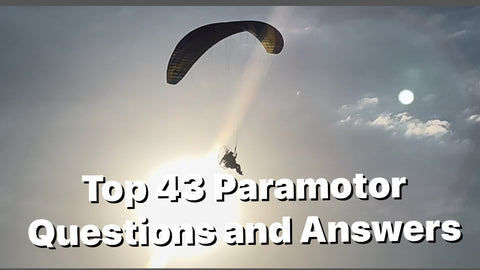Top 43 Paramotor Questions and Answers

-
- Paramotoring is a form of powered paragliding, combining a paraglider wing with a motorized backpack unit for personal flight.
-
- When practiced responsibly with proper training, paramotoring is considered relatively safe.
-
How do I get started with paramotoring?
- Enroll in a reputable paramotor training school to learn essential skills and safety protocols.
-
What equipment do I need for paramotoring?
- Basic equipment includes a paramotor unit, paraglider wing, harness, helmet, and potentially a reserve parachute.
-
How long does it take to learn paramotoring?
- Training duration varies, but on average, students spend a few weeks completing ground school and practical flight training.
-
What's the weight limit for paramotoring?
- Weight limits vary; paramotors generally accommodate pilots weighing between 150 to 300 pounds.
-
- Yes, but water paramotoring requires specific training, safety precautions, and the use of flotation devices.
-
Are there restrictions on where I can paramotor?
- Regulations vary by location; pilots must adhere to local aviation laws and avoid restricted zones.
-
How do I check weather conditions for paramotoring?
- Utilize reliable weather apps, consider wind speed/direction, and avoid adverse conditions like strong winds or storms.
-
What maintenance is required for paramotors?
- Regular maintenance includes engine checks, wing inspections, and following the manufacturer's guidelines.
-
- Altitude is limited by regulations; pilots typically fly below certain heights to ensure safety.
-
- Night flying regulations vary; some countries allow it with proper training and equipment.
-
What's the cost of paramotor training?
- Training costs vary by school; expect to spend a few thousand dollars for a comprehensive course.
-
Are paramotors legal everywhere?
- Legalities depend on local aviation laws; check regulations for your specific area.
-
How do I choose the right paramotor wing?
- Consider factors like wing size, wing loading, and your skill level when choosing a paramotor wing.
-
Can I fly a paramotor with a passenger?
- Generally, paramotors are designed for single-pilot use; flying with a passenger may require specific training and equipment.
-
What's the lifespan of a paramotor?
- Lifespan varies based on usage and maintenance; well-maintained paramotors can last for many years.
-
How do I transport a paramotor?
- Paramotors can be disassembled for transport; many pilots use trailers or secure them to vehicles.
-
Can I paramotor in cold weather?
- Yes, but pilots should dress appropriately and consider the impact of cold temperatures on engine performance.
-
What's the average flight time for a paramotor?
- Flight time varies based on factors like fuel capacity and engine efficiency; typically ranges from 2 to 4 hours.
-
How do I navigate airspace when paramotoring?
- Learn and adhere to local airspace regulations to ensure safe and legal flying.
-
What's the difference between 2-stroke and 4-stroke paramotors?
- Engine type affects weight, fuel efficiency, and maintenance; both have their advantages, and the choice depends on personal preference.
-
Can I paramotor in urban areas?
- Flying in urban areas may be restricted; check local regulations to avoid legal issues.
-
How do I handle emergency situations while paramotoring?
- Training covers emergency procedures, including engine out scenarios and reserve parachute deployment.
-
What's the impact of altitude on paramotor performance?
- Paramotors may experience reduced engine performance at higher altitudes due to thinner air.
-
Can I paramotor in windy conditions?
- Flying in strong winds requires advanced skills; beginners should avoid excessive wind speeds.
-
How do I choose the right paramotor engine?
- Consider factors like power, weight, and fuel efficiency when selecting a paramotor engine.
-
- Paramotoring in rain is generally discouraged due to safety concerns; water can affect engine performance.
-
What's the role of reserve parachutes in paramotoring?
- Reserve parachutes provide an additional safety layer in case of emergencies; pilots should be trained in their use.
-
Are there age restrictions for paramotoring?
- Age requirements vary by country; some regions may have age limits for paramotor training.
-
How do I choose the right paramotor helmet?
- Helmets should meet safety standards and be comfortable; consider features like noise reduction and ventilation.
-
Can I paramotor with a disability?
- Paramotoring with a disability may be possible with adapted equipment and proper training; consult with experienced instructors.
-
What's the role of wing loading in paramotoring?
- Wing loading affects wing performance; it's the ratio of the pilot's weight to the wing's surface area.
-
How do I maintain my paramotor wing?
- Follow manufacturer guidelines for wing maintenance, including inspections and repairs.
-
What's the role of torque compensation in paramotors?
- Torque compensation systems counteract the rotational forces produced by the engine, enhancing stability.
-
Can I paramotor in mountainous regions?
- Mountain flying requires additional skills due to unique wind patterns and terrain challenges.
-
How do I handle crosswind takeoffs and landings in paramotoring?
- Training covers techniques for safely taking off and landing in crosswind conditions.
-
What's the impact of humidity on paramotor performance?
- High humidity can affect engine performance; pilots should consider weather conditions before flying.
-
Can I paramotor in hot weather?
- Paramotoring in hot weather is possible; pilots should stay hydrated and consider the impact of temperature on engine performance.
-
How do I choose the right paramotor reserve parachute?
- Select a reserve parachute based on your weight, paramotor size, and other factors; consult with experts for guidance.
-
What's the process of getting a paramotor license?
- Paramotoring often doesn't require a license, but proper training is essential; some countries may have specific certification requirements.
-
What's the difference between foot-launch and wheel-launch paramotors?
- Foot-launch paramotors involve taking off on foot, while wheel-launch paramotors use wheels for takeoff and landing.
-
How do I troubleshoot common paramotor engine issues?
- Training covers basic engine troubleshooting, including starting,